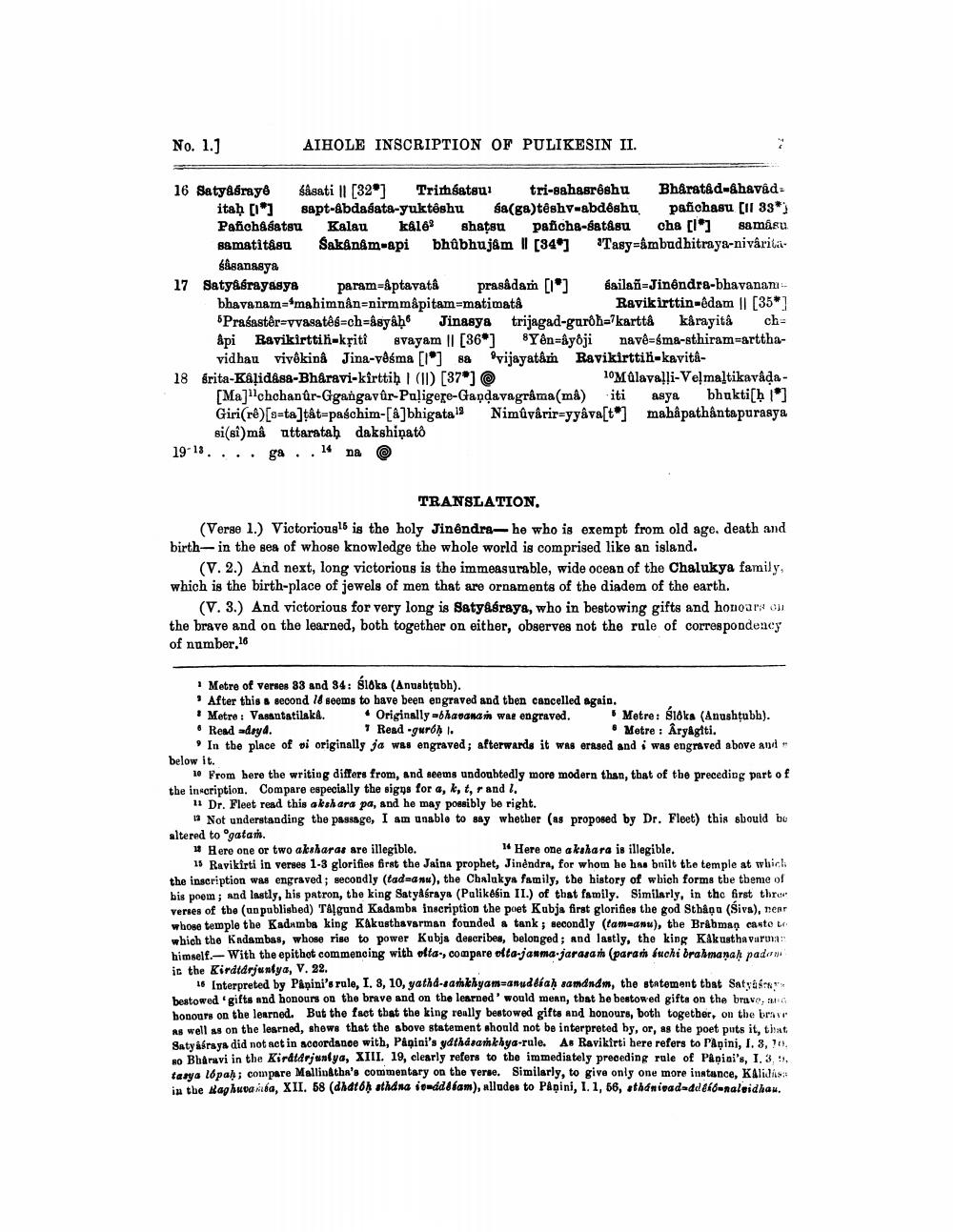________________
No. 1.)
AIHOLE INSCRIPTION OF PULIKESIN II.
16 Satyagrayê såsati Il [32] Trimsatsu: tri-sahasr@shu Bharatad-&havad:
itaḥ [*] Bapt-Abdagata-yuktêshu sa(ga)téshy-abdoshu pafichasu (11 33*) Pañich&satsu Kalau k&16% shatsu pañche-satasu cha [lo] samasu Bamatitagu Sakånám-api bhubhujâm ll [34] Tasy=&mbudhitraya-nivaritä
Sasanasya 17 Satyasrayasya param=&ptavatâ prasâdam ) Sailañ-Jinêndra-bhavanan bhavanam'mahimnân=nirmmåpitam=matimata
Ravikirttin-edam || [35*] 5Prasastêr-vvasatês=ch=Asyah Jinasya trijagad-gurðh=7 kartta kårayitá ch= ápi Ravikirttik-kriti svayam || [36] SYên=âyoji navê=sma-sthiram-arttha
vidhau vivêkina Jina-vêśma [l*] sa "vijayatâm Ravikirttih-kavita18 grita-Kalidasa-Bharavi-kirttih (ID) [37]
10Múlavalli-Veļmaltikavåda[Majichchan ür-Ggangavûr-Puligere-Gaņdavagráma(ma) iti asya bhukti[h 1*] Giri(ré)[s-ta]t&t=paschim-[&]bhigata! Nimuvärir-yyava[t] mahåpathåntapurasya
si(si)mâ attarataḥ dakshinato 19-13. ...ga . . 14 na
TRANSLATION, (Verse l.) Victorious is the holy Jinêndra- he who is exempt from old age. death and birth in the sea of whose knowledge the whole world is comprised like an island.
(V. 2.) And next, long victorious is the immeasurable, wide ocean of the Chalukya family, which is the birth-place of jewels of men that are ornaments of the diadem of the earth.
(V. 3.) And victorious for very long is Satyasraya, who in bestowing gifts and honoars on the brave and on the learned, both together on either, observes not the rule of correspondency of number.16
Metre of verses 88 and 34: 618ka (Anushtabh). . After this & second 18 seems to have been engraved and then cancelled again. * Metre : Vasantatilaka. Originally-bhavanan wae engraved. "Metre: sloks (Anushțubh). • Read mdryd. Read -guróh I.
• Metre : Aryagtti. In the place of di originally ja was engraved; afterwards it was erased and i was engraved above and
below it.
2. From here the writing differs from, and seems undoubtedly more modern than that of the preceding part of the inscription. Compare especially the signs for a, k, l, r and I.
11 Dr. Fleet read this akshara pa, and he may possibly be right.
13 Not understanding the passage, I am unable to say whether (as proposed by Dr. Fleet) this sbould bu altered to ogatan. Here one or two akaharas are illegible.
1 Here one akshara is illegible. 15 Ravikirti in verses 1-3 glorifies first the Jaina prophet, Jinèndra, for whom he has built the temple at which the inscription was engraved; secondly (tadeanu), the Chalukya family, the history of which forms the theme of bis poem; and lastly, his patron, the king Satyasraya (Palikesin II.) of that family. Similarly, in the first thro verses of the (un published) Tagund Kadamba inscription the poet Kubja first glorifies the god Sthåņa (Śiva), near whose temple the Kadamba king Kakusthavarman founded a tank; secondly (tam=anu), the Bråbman casto tri which the Kadambas, whose rise to power Kubja describes, belonged ; and lastly, the king Kakusthavaruar himself. With the epithot commencing with ofta, compare ofta-janma.jarasan (para fuchi brahmanah pada ic the Kirdtarjunya, V. 22.
16 Interpreted by Pånini's rule, I. 3, 10, yathd-sankhyamranuddiah samdndm, the statement that Satya bestowed gifts and honours on the brave and on the learned' would mean, that be bestowed gifta on the brave, honours on the learned. But the fact that the king really bestowed gifts and honours, both together, on the brave as well as on the learned, shows that the above statement should not be interpreted by, or, as the poet puts it, that Satyábraya did not act in accordance with, Påşini's ydthasankhya-rule. As Ravikirti here refers to PAộini, I. 3, !.. RO Bharavi in the Kirdtarjunya, XIII. 19, clearly refers to the immediately preceding rule of Papini's, 1.3.!), tawa lopah; compare Mallin&tba's commentary on the verse. Similarly, to give only one more instance, KAH in the Naghuvaba, XII. 58 (dhatoh athana iondd diam), alludes to Papini, 1. 1, 66, athaniead=dd&ibunaleidhau.




